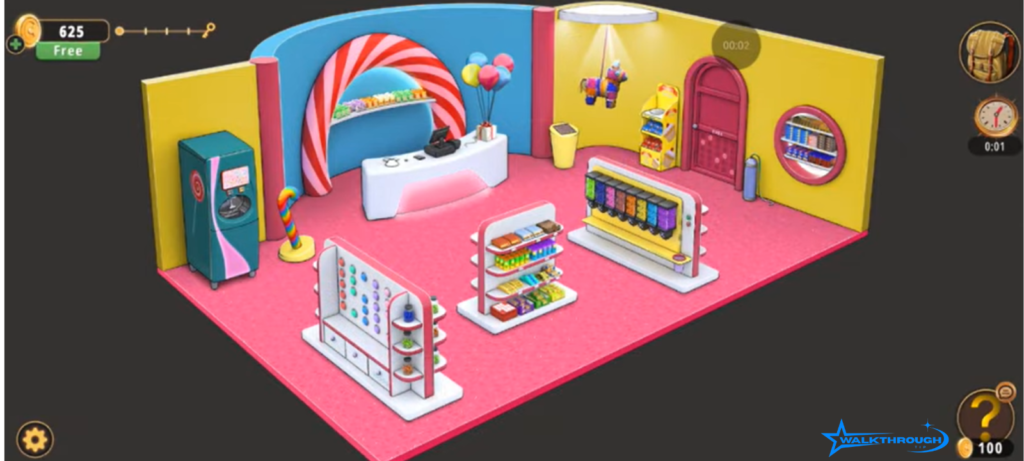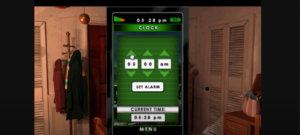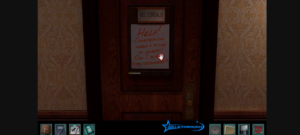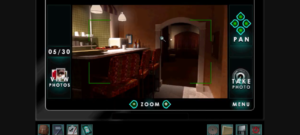
Introduction
Rooms and Exits Walkthrough Candy Shop is one of the most engaging puzzle levels in the popular game “Rooms and Exits.” This guide is tailored for Chapter 1 Level 11, which takes place inside a charming, yet deceptively tricky candy shop setting. In this walkthrough, we explore every nook and cranny of the level, detailing hidden items, secret puzzles, and clever tricks that game developers use to test players’ observational skills and strategic thinking.
At “Walk Through Tip,” our commitment is to provide clear, thorough, and precise guidance so players can progress with confidence. This article not only navigates you through the challenges of the candy shop but also delves into the game mechanics and puzzle logic underlying each step. Whether you are a seasoned player or a newcomer struggling with the puzzles, our comprehensive guide on rooms and exits walkthrough candy shop will help you master the level and enjoy the game even more.
About Chapter 1 Level 11: Candy Shop
Chapter 1 Level 11 in the “Rooms and Exits” game is set in a vibrant candy shop environment. Here, the festive setting meets mind-boggling puzzles that demand careful observation and sharp thinking. Players step into a scene filled with sugary delights, colorful decor, and hidden surprises that create an immersive gaming experience.
Environment Description
The candy shop in this chapter is designed to look inviting, with:
- Bright Color Schemes: The walls, counters, and shelves are adorned with hues of pink, blue, and yellow, echoing the playful nature of candy.
- Intricate Details: Every corner of the shop hides secret clues ranging from subtle reflections in candy jars to cleverly arranged candies on display.
- Immersive Sounds: Background music and sound effects contribute to a bustling, yet mysterious atmosphere, keeping the player both relaxed and alert.
Goals and Objectives
In this level, players have several intertwined objectives:
- Collecting Items: Before unlocking the exit, players must gather key objects like the wallet, balloon, candy cane, and jar.
- Interacting with the Environment: Each item interacts with different aspects of the environment solving physical puzzles and unlocking hidden compartments.
- Solving Puzzles: Puzzles range from memory games to logic challenges that use the theme of candy and sweets to create a unique gameplay experience.
How It Fits into the Game
The candy shop level acts as a bridge between introductory tutorials and more challenging levels in later chapters. Here, the game introduces essential mechanics such as:
- Inventory Management: Understanding how to combine items and use them effectively.
- Mini-Game Integration: Incorporating puzzles that test memory, logic, and pattern recognition, crucial for progressing in subsequent levels.
By mastering these tasks in the candy shop, players build a strong foundation for handling even more complex challenges later in the game.
Step-by-Step Walkthrough
The following section provides a detailed guide to navigating Chapter 1 Level 11, also known as the rooms and exits walkthrough candy shop level. We cover everything from initial entry to the final escape, ensuring you have all the necessary insights to beat the level.
Entering the Candy Shop
The very first moments in the candy shop are critical. As soon as you enter, take a few moments to absorb the environment and identify potential points of interest. Here’s how to get started:
- Observation is Key: Look around for objects that stand out. Commonly, items like wallets, keys, or even unusual candies serve as hints toward solving the puzzles.
- Initial Items to Note:
- Wallet: Usually found near the counter or on a table. The wallet might contain essential clues or even a code.
- Balloon: Suspended or hidden in a corner, the balloon is sometimes used in conjunction with other items.
- Candy Cane: Often placed in decorative arrangements, this candy cane might need to be collected before a puzzle triggers.
- Wallet: Usually found near the counter or on a table. The wallet might contain essential clues or even a code.
- Environmental Details: Observe the layout of the shelves, display cases, and behind-the-counter compartments. The layout is intentionally designed to mislead, so note any discrepancies such as an odd reflection or an object that seems out of place.
Key Tip: Make sure to document or mentally note every detail. Missing even one item in the initial scan can mean wasted time as you backtrack later.
Finding and Using Items
After the initial exploration, it’s time to focus on item collection and utilization. The success in a rooms and exits walkthrough candy shop level largely depends on correctly identifying and using these hidden objects.
Key Items to Collect
Below is a table summarizing the items to look for and their potential uses:
| Item | Location | Purpose/Use |
| Wallet | Near the counter or on a table | May contain clues like partial codes or keys needed to open other compartments. |
| Balloon | Suspended from a hook or hidden in a corner | Used to manipulate objects; for example, inflate to reach items or to fill gaps that reveal hidden clues. |
| Candy Cane | Displayed on shelves or in decorative elements | Often serves as a lever or part of a combination puzzle, aligning objects in a specific pattern to unlock further sections. |
| Jar | Behind display counters or on shelves | Once activated by the balloon, jars can reveal hidden compartments or contain puzzles that need to be solved to progress further. |
How to Use the Items
- Wallet:
- Open the wallet immediately upon collection to review its contents.
- Look for a small note or a card inside that suggests the location of another item.
- Use any numbers or letters as hints for code-related puzzles later.
- Open the wallet immediately upon collection to review its contents.
- Balloon:
- When the balloon is found, experiment with it by trying to inflate or deflate.
- In one scenario, the balloon might need to be inflated near a specific jar to nudge it aside and reveal a hidden button.
- In other puzzles, the balloon serves as a distraction or a tool to press hard-to-reach buttons.
- When the balloon is found, experiment with it by trying to inflate or deflate.
- Candy Cane:
- Check the candy cane for any inscriptions or color patterns.
- Its curved shape might hint at a corresponding mechanism within the candy shop look for a slot or a matching pattern on a vending machine or a decorative piece.
- Check the candy cane for any inscriptions or color patterns.
- Jar:
- Often, the jar only reveals its secret once activated by the balloon.
- Gently tap the jar or move the balloon near it to trigger a hidden panel that might include additional inventory items or clues.
- Often, the jar only reveals its secret once activated by the balloon.
Important Fact: Multiple items can combine to solve single puzzles. For instance, the candy cane might need to be used together with the jar to set off a sequential response that unlocks a compartment.
Solving the Mini-Games
The candy shop level doesn’t only rely on hidden item mechanics; it also integrates mini-games that challenge players to think outside the box. These puzzles are designed to be mentally stimulating and to add variety to the gameplay. Below are some of the mini-games and puzzles you’ll encounter.
1. Memory Matching Mini-Game
- Objective:
Find pairs of matching candy-themed images hidden throughout the shop. - How to Play:
- Look around the background for slightly faded images on wallpaper or behind decorations.
- Flip the cards or select objects in pairs.
- A correct match might reveal a number or letter that is crucial for opening a locked door later on.
- Look around the background for slightly faded images on wallpaper or behind decorations.
- Tip:
Write down the identified pairs and compare them with the clues you might find in your wallet or on posters around the shop.
2. Candy-Themed Sudoku Puzzle
- Objective:
Solve a simple logic-based grid puzzle where numbers or candy colors must be arranged without repeating in any row, column, or designated box. - Puzzle Setup:
- The grid is themed with candies (color-coded items) rather than numbers.
- Each candy color or number must be unique within its defined space.
- The grid is themed with candies (color-coded items) rather than numbers.
- Solution Strategy:
- Use the elimination method commonly found in Sudoku puzzles.
- Identify which candy colors have already been placed; this will help deduce the placement of the remaining ones.
- Use any pattern clues available through environmental details such as stickers, posters, or lines on the floor.
- Use the elimination method commonly found in Sudoku puzzles.
3. The Register and Cash Drawer Code Puzzle
- Objective:
Unlock the cash register or a hidden drawer by entering the correct code. - Clues to Look For:
- Clues might be scattered around, such as numbers written on paper bags or printed on hidden signs.
- The wallet’s contents or the memory game may also provide partial sequences.
- Clues might be scattered around, such as numbers written on paper bags or printed on hidden signs.
- Steps to Solve:
- Gather the numerical clues.
- Use logical reasoning to arrange them in the correct sequence.
- Test a few combinations if the game allows for retrying without harsh penalties.
- Gather the numerical clues.
4. Combination Lock and Numeric Puzzles
- Objective:
Solve puzzles that involve aligning sequences or manipulating symbols until you unlock an exit or a storage compartment. - Key Considerations:
- Pay attention to background details; sometimes the color of candies, patterns on walls, or even the background music tempo can offer hints.
- Check if clues repeat in multiple areas which could suggest a connection between puzzles.
- Pay attention to background details; sometimes the color of candies, patterns on walls, or even the background music tempo can offer hints.
Note: Each mini-game is integrated with other parts of the level, meaning solving one may yield hints for the next. Always keep track of any new details you discover because they can often be cross-referenced with other puzzles in the rooms and exits walkthrough.
Unlocking the Final Door
After collecting items and solving the mini-games, the final step in the candy shop level is to unlock the exit door. This is where all the skills you’ve used throughout the level come together.
Steps to Unlock the Door:
- Inventory Review:
- Open your inventory and verify that you have collected the wallet, balloon, candy cane, jar, and any other special items.
- Recheck any clues provided within the wallet or on screen to ensure no detail is overlooked.
- Open your inventory and verify that you have collected the wallet, balloon, candy cane, jar, and any other special items.
- Combine Clues:
- Use clues from the register, memory game, and any environmental hints gathered during exploration.
- Often the correct sequence involves aligning colors, numbers, or items in a specific order as indicated by subtle hints around the candy shop.
- Use clues from the register, memory game, and any environmental hints gathered during exploration.
- Final Puzzle Execution:
- Approach the locked door and observe if there is a numeric keypad, colored symbols, or a pattern insertion slot.
- Enter the code or arrange the items according to the gathered clues. For example, if the cashier’s check indicates the order “candy cane – jar – balloon,” ensure this sequence is reflected in your final move.
- Listen for auditory or visual confirmation (like a clicking sound or the door light changing color), confirming that the door is unlocked.
- Approach the locked door and observe if there is a numeric keypad, colored symbols, or a pattern insertion slot.
Troubleshooting the Final Puzzle
If the door doesn’t unlock immediately, consider these possible causes:
- Misinterpreting a Clue:
Revisit previous steps and check if any small detail was misinterpreted. Sometimes a subtle change in the background reveals the correct order. - Overlooked Items:
Review your inventory to verify whether you missed an item or if an item was used in the wrong sequence earlier. - Time-Sensitive Actions:
Some puzzles may have a timing element. If you’ve activated a trigger too soon or too late, try resetting the puzzle by restarting the level segment and following the instructions carefully.
A clear mind and a systematic review of collected clues typically ensure success. Once you’ve executed the final steps correctly, the door will open, allowing you to progress further in the game.
Tips and Tricks
Even the best-prepared player can benefit from extra tips and tricks. Here are several strategies to help you master the rooms and exits walkthrough candy shop level:
General Gameplay Tips
- Stay Organized:
Keep a mental or physical checklist of items as you collect them. A quick note on where and how an item was found can save a lot of time. - Careful Observation:
Always examine every corner of the environment. The game developers intentionally hide clues in less obvious places like behind shelves or within reflections. - Patience:
Rushing can make you miss critical clues. Take your time to ensure every detail is noted.
Specific Level Tricks
- Utilize Inventory Wisely:
Items can often be used in multiple parts of the puzzle. Experiment by combining items in different sequences if you’re unsure of their use. - Listen and Look:
Sound cues and subtle visual changes are key indicators of progress. A slight change in background music or lighting might indicate that you have activated a hidden mechanism. - Take Advantage of Hints:
Some parts of the level might offer hints in the form of posters or notes left casually on counters. Always read them; these hints might be the key to unlocking a complex puzzle later.
Helpful Table: Key Actions and Outcomes
| Action | Outcome/Benefit | When to Do It |
| Check every shelf and display case | Discover hidden items like the wallet or candy cane | Immediately after entering the level |
| Combine items in your inventory | Solves multi-stage puzzles by using clues from various sources | When facing a multi-component puzzle |
| Revisit earlier locations | Verify if any overlooked clues have been missed | After failing a puzzle attempt |
| Engage with mini-games carefully | Unlock numerical codes or color sequences essential for the exit | Before attempting the final door puzzle |
Trivia and Fun Facts
- Game Design Insight:
The integration of sensory cues (sound and color) is not just for ambiance; it’s a deliberate design strategy that enhances the player’s immersive experience and reinforces memory cues. - Puzzle Interconnectivity:
Many of the puzzles in the candy shop are interrelated. Solving one puzzle often provides a crucial hint that resonates with another part of the level, emphasizing the importance of a holistic view.
By employing these tips and tricks, you ensure a smoother progression and a deeper understanding of the underlying mechanisms behind the rooms and exits walkthrough candy shop level.
Benefits of Watching a Video
- Visual Demonstrations:
Videos provide a clear demonstration of complex mini-games and how to interact with inventory items. - Step-by-Step Guidance:
You can pause and replay specific sections to better understand challenging segments. - Enhanced Engagement:
For visual learners, watching actions performed in real time can reinforce written instructions and improve retention.
Integrating a video walkthrough with our detailed textual guide creates a comprehensive resource that caters to multiple learning styles and ensures that no player is left behind.
Frequently Asked Questions (FAQs)
Below are some of the most common questions that players ask regarding the rooms and exits walkthrough candy shop level. This section is designed to provide quick solutions and clarifications.
Where is the Balloon Located?
The balloon is typically found hanging near the ceiling or tucked into a decorative corner of the candy shop. It may require you to interact with nearby objects to reveal its exact location. If you’re having trouble spotting it, check areas that seem less frequented by the main action and always keep an eye on background details.
How Do I Use the Candy Cane?
The candy cane may serve as a key component of a combination puzzle. Often, it needs to be applied to a matching slot or in conjunction with other items such as the jar. Look for matching color cues or specific patterns on the shop’s display items that might indicate its use.
What Should I Do if the Wallet Doesn’t Open?
Sometimes the wallet might look like it’s locked or sealed. Ensure you have activated previous puzzles which might “unlock” the wallet’s functionality. Check again for any subtle hints on nearby surfaces or within the game’s environment that indicate a specific sequence to open it.
How Can I Solve the Mini-Games More Easily?
For memory matching mini-games, jot down what you observe or take screenshots if possible. For the candy-themed Sudoku, identify the fixed elements first and use process-of-elimination to fill in the gaps. If a mini-game seems overwhelming, take a brief pause and revisit the clues in your environment they are usually interconnected.
What Is the Final Code to Unlock the Door?
The final code is usually assembled through clues found during the gameplay including hints within the wallet, register, and mini-games. There is no one-size-fits-all answer as it may change subtly based on your progression. Ensure you have noted all numerical or color sequences provided throughout the level.
Final Thoughts
In conclusion, the Complete Rooms and Exits Walkthrough for Chapter 1 Level 11 is all about observation, patience, and smart puzzle-solving. This candy shop level, with its whimsical setting and layered puzzles, represents a perfect balance of fun and challenge. By following the step-by-step instructions in this guide, you should be well-prepared to conquer every aspect of the level.








